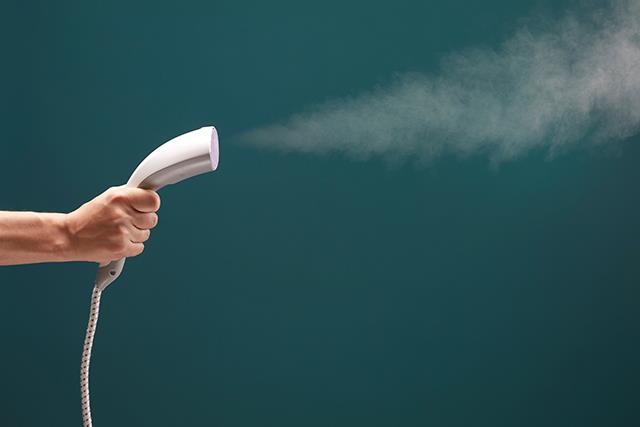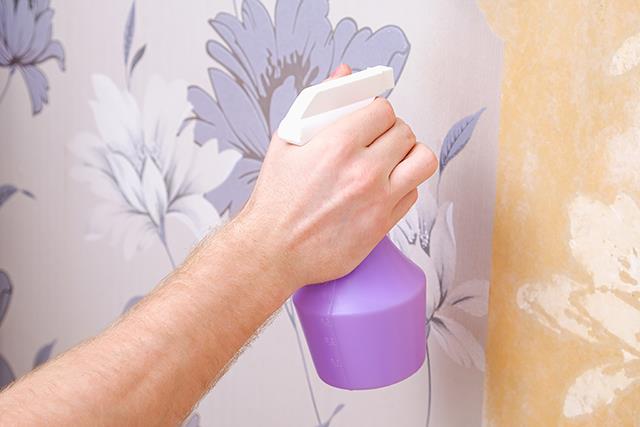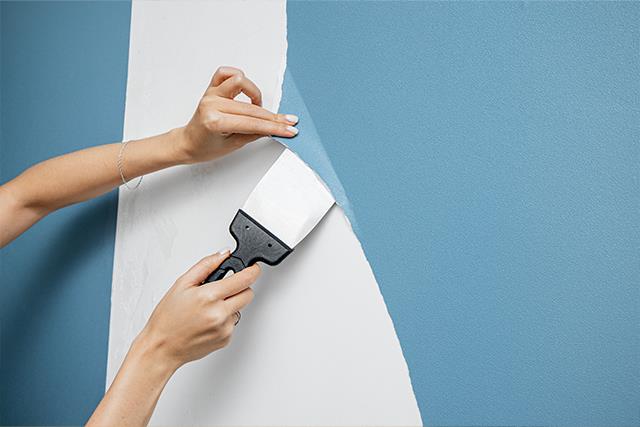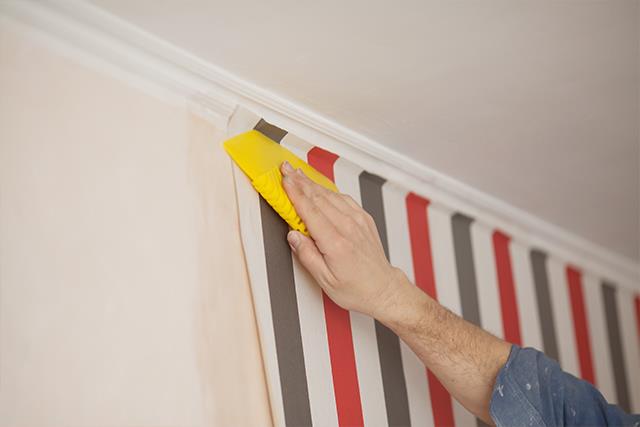Removing wallpaper sounds more complicated than it is. It requires patience since removing wallpaper is a repetitive chore, but it's doable. Approach this project with a plan and determine which method you prefer.

Before you begin
There are three recommended methods, and with each of them, you'll be soaking the wallpaper, which will cause excessive drips on the floor. To protect your floors and baseboards, lay down towels, cardboard, or a drop cloth to catch the wet paper and drips as they fall.
Tools:
Wallpaper steamer, putty knife, clean sponge, wallpaper scoring tool, water and vinegar, spray bottle, liquid Stripper, sheet plastic and tape.
Method 1: Steam Removal
Prepare the Steamer

Fill the steamer reservoir full of water up to the waterline mark. Do not overfill the steamer. Attach the handle and hose to the large steamer plate. Plug in the machine and turn it on. Wait for the machine to build up steam. Most devices will have indicator lights that tell you when the machine is ready. This can take five or 10 minutes.
Steam the Wallpaper
To protect your floors and baseboards, tape down sheet plastic to catch the wet paper and drips as they fall. Lay the plate on a wallpaper section and press the trigger for 15 to 20 seconds. Immediately remove the plate.
Remove the Wallpaper
Immediately begin peeling up that section of the wallpaper with the putty knife. If this isn't working well, score the wallpaper with the wallpaper scoring tool. Steam that section again and try peeling it up. Continue with the process until the wallpaper is gone.
Clean Up the Adhesive
After the paper has been removed, re-steam so you can scrape up any residual adhesive. Once the adhesive is removed, use a new, damp sponge to wipe down the wall.
Method 2: Water and Vinegar
Mix equal parts white vinegar and water in a spray bottle. Saturate the wallpaper. Spray an area generously with the vinegar water solution. Once soaked, the paper will separate from the walls.
Method 3: Liquid Stripper

Apply the Wallpaper Stripper
Tape sheet plastic on the floor and use it to cover the areas of the wallpaper that will not be removed. Turn the wallpaper stripper bottle nozzle to the "on" position. Spray the product and use a sponge to distribute it over an area. Wait for five minutes as the product penetrates the paper.
Begin the Removal

Gently push the putty knife under the paper and lift it away. Do not scrape or gouge the wall with the knife. The wallpaper should easily lift off. If it doesn't lift away easily, score the wallpaper with the scoring tool.
Repeat the Process
Apply more wallpaper stripper product and let it rest for five minutes. Repeat the process of lifting the wallpaper off with the putty knife. You might have to do this several times to remove the wallpaper entirely.
How to apply wallpaper to your project

The best type of wallpaper to use on surfaces other than walls is vinyl wallpaper. This type of wallpaper already has a protective finish that allows you to wipe it clean.
Whatever project you are tackling, it's always best to lightly sand the surface with 180-grit sandpaper before you stick down the wallpaper. This light sanding will provide a better surface for the wallpaper paste to stick onto. Be sure to wipe clean after sanding.
Use a tape measure to determine the size of wallpaper pieces you need to cut, and cut these neatly with a sharp craft knife and steel ruler.
Mix up the wallpaper paste according to the instructions and then place all your pieces on a covered worktop, so that you can apply the paste to the back.
Gently lift up the pasted pieces and carefully place them on your project, making sure to accurately line up edges before pasting down. Use a sponge to wipe across the surface from the centre to the sides, top and bottom to ensure that there are no air bubbles.
Pay particular attention to edges, as these are the areas most likely to lift or peel back if not pasted and stuck down.
For added protection, such as on a tabletop, apply two coats of clear acrylic sealer over the wallpapered project - or cover with a layer of 5mm glass cut to size.
Article courtesy of www.home-dzine.co.za, TheSpruce
Want all the latest property news and curated hot property listings sent directly to your inbox? Register for Property24’s Hot Properties, Lifestyle and Weekly Property Trends newsletters or follow us on Twitter, Instagram or Facebook.








